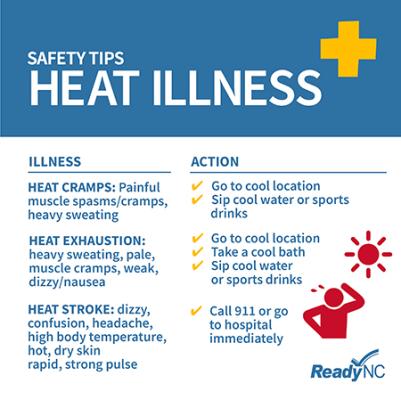Author: Meredith Hemphill
Most people consider August the last month of summer—the last chance for beach days, cookouts and pool parties. While North Carolinians are squeezing every last drop of fun and relaxation out of the summer season, remember to protect yourselves from the sun and the heat. August is Summer Sun Safety Month in the United States, reminding us to stay safe during outdoor activities.
Ultraviolet Light and Sun Protection
Although sunlight is the energy that powers all life on Earth, it can also injure the skin and eyes. The ultraviolet radiation in sunlight, also known as UV light, is invisible to the human eye but is powerful enough to penetrate the skin, damaging cells and even causing DNA mutations that lead to cancer. According to the American Academy of Dermatologists, skin cancer is the most common type of cancer, and most skin cancers are caused by overexposure to UV light. Your eyes are also sensitive to sunlight. Too much UV light in the eyes can lead to cataracts and eye cancer.
This doesn’t mean you need to hide in a windowless basement forever. In fact, the human body needs regular exposure to sunlight to produce Vitamin D (about 10-30 minutes several times per week). You just need to be careful to protect your skin and eyes anytime you engage in outdoor activities, especially between 10 a.m. and 4 p.m. when the sunlight is strongest.
Some additional sun protection steps include:
- Apply a broad-spectrum sunscreen with a Sun Protection Factor of at least 30. Reapply every two hours.
- Wear loose, lightweight clothing that covers your arms and legs. Consider clothing with an Ultraviolet Protection Factor number on the label for even more protection.
- Wear a wide-brimmed hat or carry an umbrella or parasol.
- Wear sunglasses that are rated to block at least 99% of both UVA and UVB rays. Large-framed or wraparound sunglasses offer more protection than smaller lenses.
- Either wear shoes that cover your feet or make sure to apply sunscreen to your feet and ankles, too.
Extreme Heat
North Carolina has already experienced triple-digit temperatures this summer. The southeast is known for its high heat and humidity this time of year, a combination which can quickly lead to heat illness. Always check the weather forecast when you have outdoor plans and know your extreme heat vocabulary so you can prepare accordingly.
Heat Index: a number that expresses how hot it feels when the relative humidity is added to the air temperature. Being in full sun can raise the heat index as much as 15 degrees Fahrenheit.
Excessive Heat Watch: an excessive heat event is likely in the next 24 to 72 hours.
Heat Advisory: heat index values are forecast to meet or exceed daytime highs of 100-105 degrees Fahrenheit for one to two days.
Excessive Heat Warning: heat index values are expected to meet or exceed daytime highs of 105-110 degrees Fahrenheit for at least two days.
When a heat advisory or warning is in effect, stay indoors and limit sun exposure as much as possible. Try to avoid working outside during the hottest hours of the day and drink lots of water. Avoid beverages with caffeine or alcohol, as these are dehydrating. If you must be outside, take breaks often and seek shade. If you are unable to stay cool at home, go to an air-conditioned public building such as a library, shopping mall or community center. Public cooling centers may be opened during extreme heat events.
Remember to check on your neighbors, especially those who are disabled, elderly or live alone. Provide plenty of water and shade for any outdoor pets or livestock and check on them often.
Summer Sun First Aid
Everyone has had a sunburn. Most are minor and don’t require much first aid, although a little aloe certainly helps. However, sunburns are burns, and they can be serious. Severe sunburns go beyond the redness and pain to swelling, blisters, fever and headaches. In the case of such a serious sunburn, wash the affected skin with soap, then apply dry, sterile bandaging to any blisters.
Heat illness occurs when the body becomes so overheated that it can’t regulate its internal temperature anymore. Heat cramps are often the first stage of heat illness, especially for people who are working outside in high temperatures. Heat cramps are painful muscle spasms, usually in the legs and abdomen, accompanied by heavy sweating. When someone is experiencing heat cramps, move them to a cooler location, gently stretch and massage the affected muscles, and provide sips of cool water.

Heat exhaustion is more serious. A person with heat exhaustion will sweat heavily but their skin may be cool, pale or flushed. They will have a fast, weak pulse and may experience dizziness, confusion, fatigue, headache, nausea and vomiting. They might faint. The first aid steps are like those for heat cramps, but in addition to moving to a cooler place and slowly giving water (as long as they are conscious and not nauseous), it is recommended to remove or loosen their clothing and cover them with cool, damp clothes or towels to cool them down faster. If they are vomiting, seek immediate medical attention.
Heat stroke, also known as sun stroke, is a medical emergency. The symptoms are similar to heat exhaustion, except the person will have a high body temperature and their skin will stop sweating and get hot and dry. Their breathing will become fast and shallow, and they may lose consciousness. In the case of heat stroke, call 9-1-1 or take the person to a hospital.
Children, the elderly and people who are sick or overweight are more susceptible to heat illness. By knowing the warning signs and what to do when the summer sun turns dangerous, you might become a summer vacation hero.
Resources:

